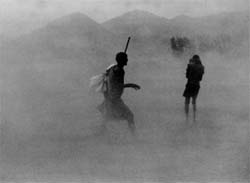Red heat
 a reconstruction of climate using lake sediments suggests that African climate in previous centuries was much lethal than in the last 30 years. "Those centuries saw huge swings in African rainfall. The fluctuations seem to be tied to variations in the radiative output of the Sun,' says Dirk Verschuren of the University of Ghent in Belgium. Higher solar radiation is linked to droughts in equatorial East Africa, he adds ( Nature, Vol 403, p410).
a reconstruction of climate using lake sediments suggests that African climate in previous centuries was much lethal than in the last 30 years. "Those centuries saw huge swings in African rainfall. The fluctuations seem to be tied to variations in the radiative output of the Sun,' says Dirk Verschuren of the University of Ghent in Belgium. Higher solar radiation is linked to droughts in equatorial East Africa, he adds ( Nature, Vol 403, p410).
Regionally, these recurring droughts may be more of a problem than global warming, says Verschuren. "In arid places like East Africa, central Asia and Australia, I think they should be much more worried about natural variability in rainfall. They need to be less dependent on hydroelectric dams and irrigated agriculture.'
Verschuren's studied a thousand years of the East African climate by analysing the sediments on the bottom of Kenya's Lake Naivasha in the Rift Valley.
"The lake is very unusual in that its level responds strongly to changes in rainfall over a few years, but it has not dried out for at least the last millennium,' he adds.
The lake sediments record the water levels. Periods of high water have a greater concentration of algae on the lake floor, which shows itself in a higher organic carbon content in the sediment left behind in annual layers. Using this and other indicators, Verschuren and his colleagues have calculated past lake levels going back 1,000 years.
There was a long dry period from 1000 to 1270, and three shorter intense droughts from 1380 to 1420, 1560 to 1620 and 1760 to 1840. Each coincided with an era of famine, political unrest and mass migration related through the oral histories of local communities. "The dates are not precise because oral histories simply count back the generations, but a synchronised pattern definitely emerges,' says Verschuren.
Perhaps the most complete study of pre-colonial African climate, Verschuren's study has thrown up some interesting findings about the early days of European colonisation too. Saysm anthropologist John Reader of the University College, London: "The continent-side drought almost certainly contributed to the immense political chaos and migrations that were partly reflected in the growth of the slave trade.'
Related Content
- Colliding Crises: How the climate crisis fuels gender-based violence
- 2024 Disasters in Numbers
- European State of the Climate Report 2024
- Learning Interrupted: Global Snapshot of Climate-Related School Disruptions in 2024
- State of the climate in Latin America and the Caribbean 2023
- Recipe for a livable planet: achieving net zero emissions in the agrifood system
